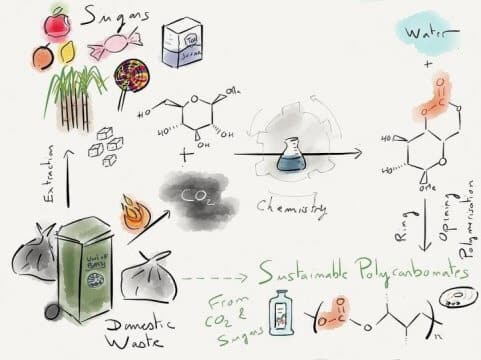In the future it will be possible to produce biodegradable plastic types using only sugar and carbon dioxide, a biodegradable plastic that will be able to convert the plastic that exists today obtained from crude oil.

[Translation by Dr. Nachmani Moshe]
Researchers from the University of Bath in the UK explain why the plastic used today in a variety of fields has many disadvantages. Polycarbonate plastic is used to produce beverage bottles, eyeglass lenses and anti-scratch coatings in digital devices such as smartphones, CD/DVDs, etc. Existing processes to create polycarbonate use substances defined as toxic to humans (bisphenol A and phosgene). To overcome this, the researchers managed to create an alternative polycarbonate from sugars and carbon dioxide in an innovative process where the conditions are low pressures and room temperature, conditions that make its production cheaper and safer. This new type of polycarbonate can break down back into its natural components while receiving carbon dioxide and sugar, this following the biological activity of enzymes found within the soil bacteria. In addition to being biodegradable, the new plastic is also adapted to the human body, and therefore it could also be used in the future for the production of medical implants or as scaffolds for the growth of replacement organs for transplants.
The plastic obtained in the new process has similar physical properties to that encountered from petrochemicals, and in the same way it is also strong, transparent and scratch resistant. The main and important difference lies in the fact that this plastic can be broken down into its natural biological components. The new plastic could replace polycarbonate plastic in items such as baby bottles and food containers.
One of the researchers explains: "In light of the continuous increase in the world's population, there is a growing demand for plastic products. The new plastic is a renewable alternative to polymers based on fossil fuels, and therefore it will be cheaper, and in light of the fact that it is also biodegradable, it will not contribute to the growing amount of waste in the oceans and underground landfills. Our process uses carbon dioxide instead of the highly toxic substance phosgene, during which a bisphenol A-free plastic is created, so that it is not only safer, but its production process is cleaner." The research findings were published in the scientific journalspolymer Chemistry also Macromolecules.
The researchers were inspired by nature - they used the sugar that is a component of DNA, thymidine, as a building block to make the new plastic. In light of the fact that this sugar unit exists in the body, the new plastic is also suitable for the body and therefore could be safely used for tissue engineering applications. "The properties of the new plastic can be adjusted by making small chemical changes - for example, the plastic can be made electrically charged, so that cells in the body will be attracted and connect to it, this is for the benefit of applications in the field of tissue and cell engineering. The researchers themselves began to test other sugar units such as ribose and mannose.

7 תגובות
Another question: if the plastic described here is biodegradable - then implants in humans that will be built from it will undergo degradation over time, but what is scary is that even before the complete degradation in the human body, it will show a decrease in its performance and desired properties (for example, implants in the body that will replace bones and joints but will quickly weaken, in contact lenses/glasses where the centers and cylinders will change over time, etc.); Would we like to use an essential material that must be replaced frequently (on a scale of days/months, years?).
Will people with diabetes be able to use the implants of this material? After all, the sugar in the process of breaking down the substance will be released into the blood (and according to logic the sugar will not necessarily be released in a uniform way depending on time) - then the blood sugar levels will not be uniform, or sometimes even too high - and will affect 35% of the population...
There are already several types of degradable plastic, the problem is that it is impossible to control this degradability and sometimes the plastic begins its degradability that is still used and then you get bad and weak plastic (for example, weak bags that tear).
Great invention, excellent!!!
In my opinion the (in)determinative - is worth a Nobel Prize for Chemistry.
The only question is:
Has the process already been developed and proven to be possible, or
which is still an idea.
Bouncer
Polycarbonate is a family of materials in which the monomers are connected to each other by carbonate bonds. It is possible to assemble a large series of monomers in this way and the identity of the monomers, of course, completely changes the properties of the polymer.
I didn't understand, first it says:
"... Polycarbonate plastic is used to make beverage bottles..."
And then it says:
"………succeeded in creating an alternative polycarbonate from sugars and carbon dioxide……."
If it is also polycarbonate, where is the difference?